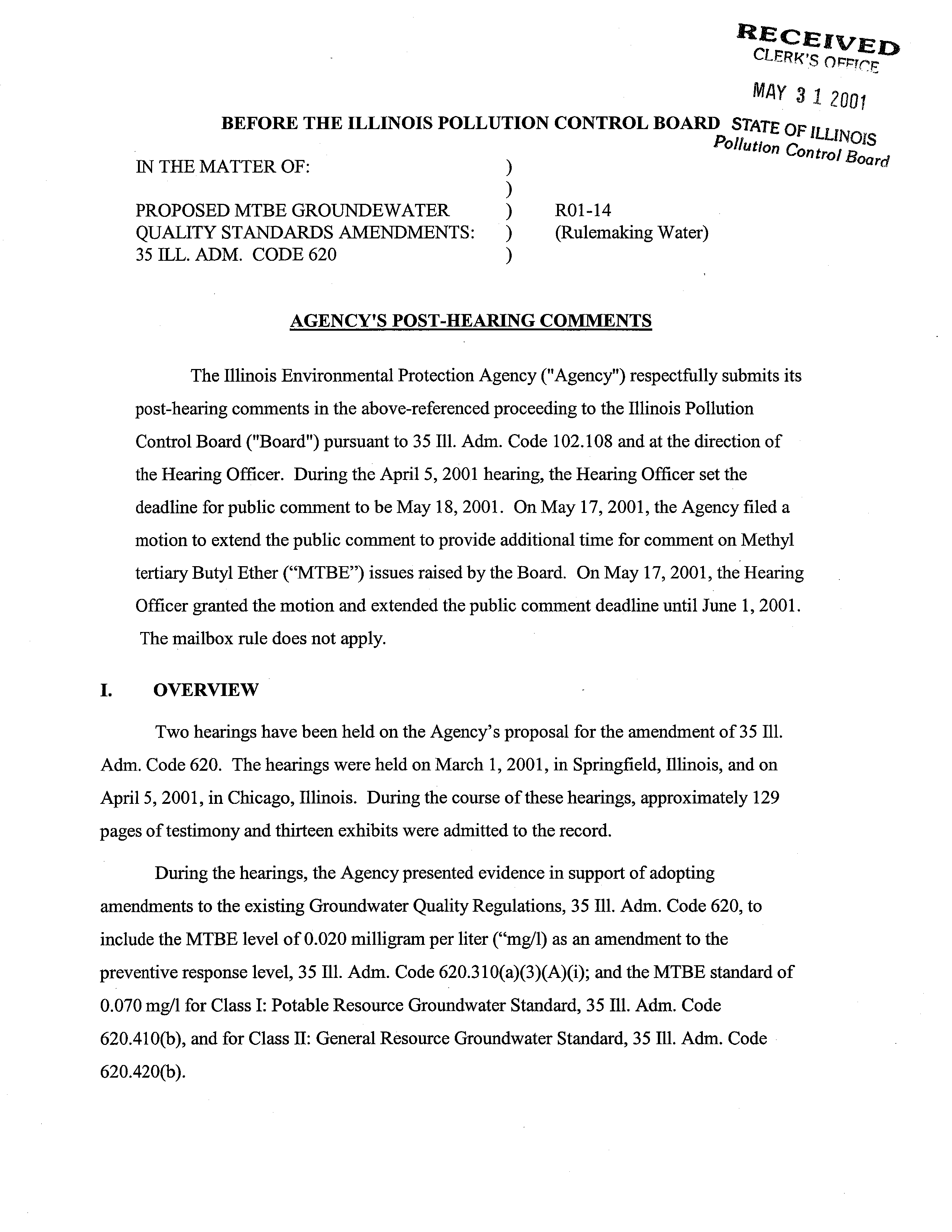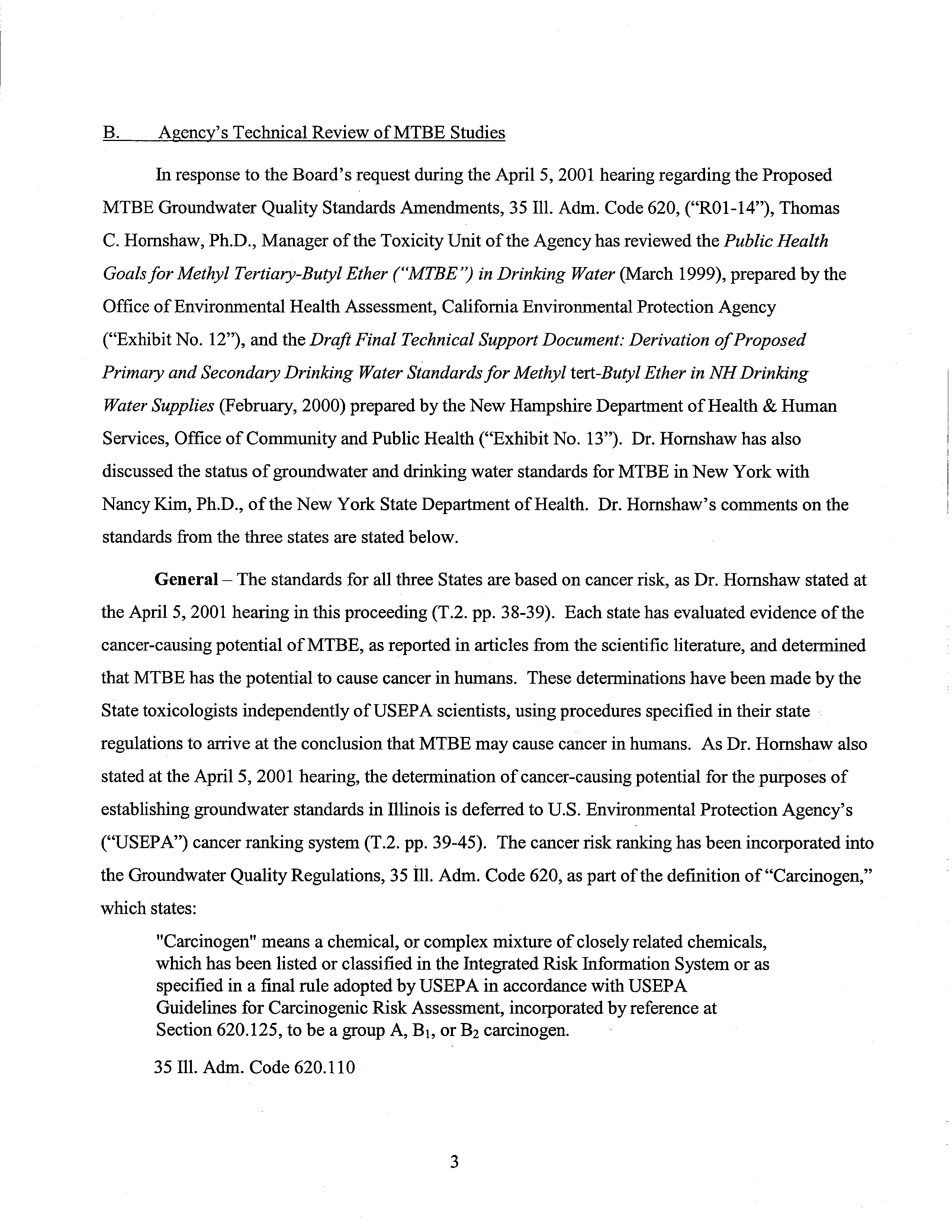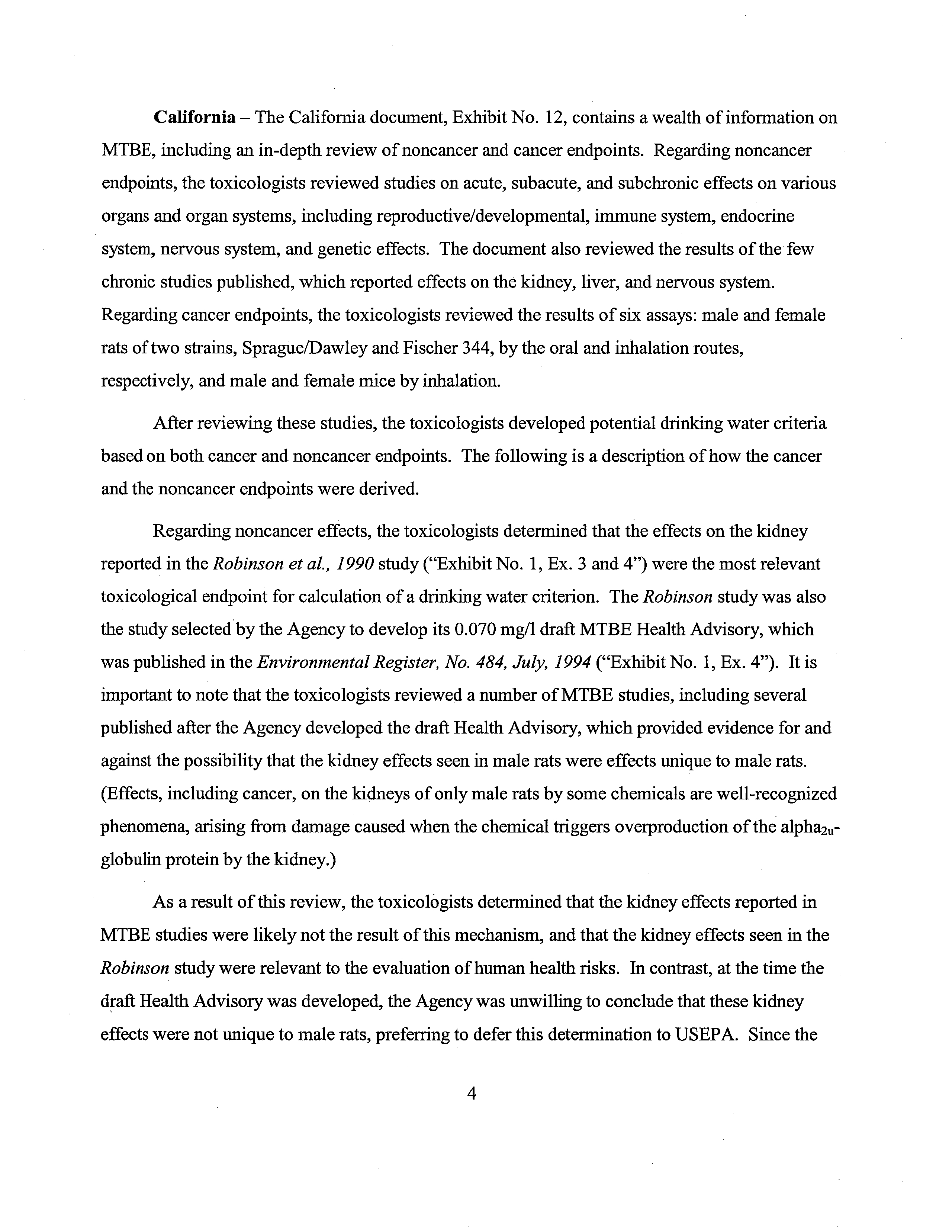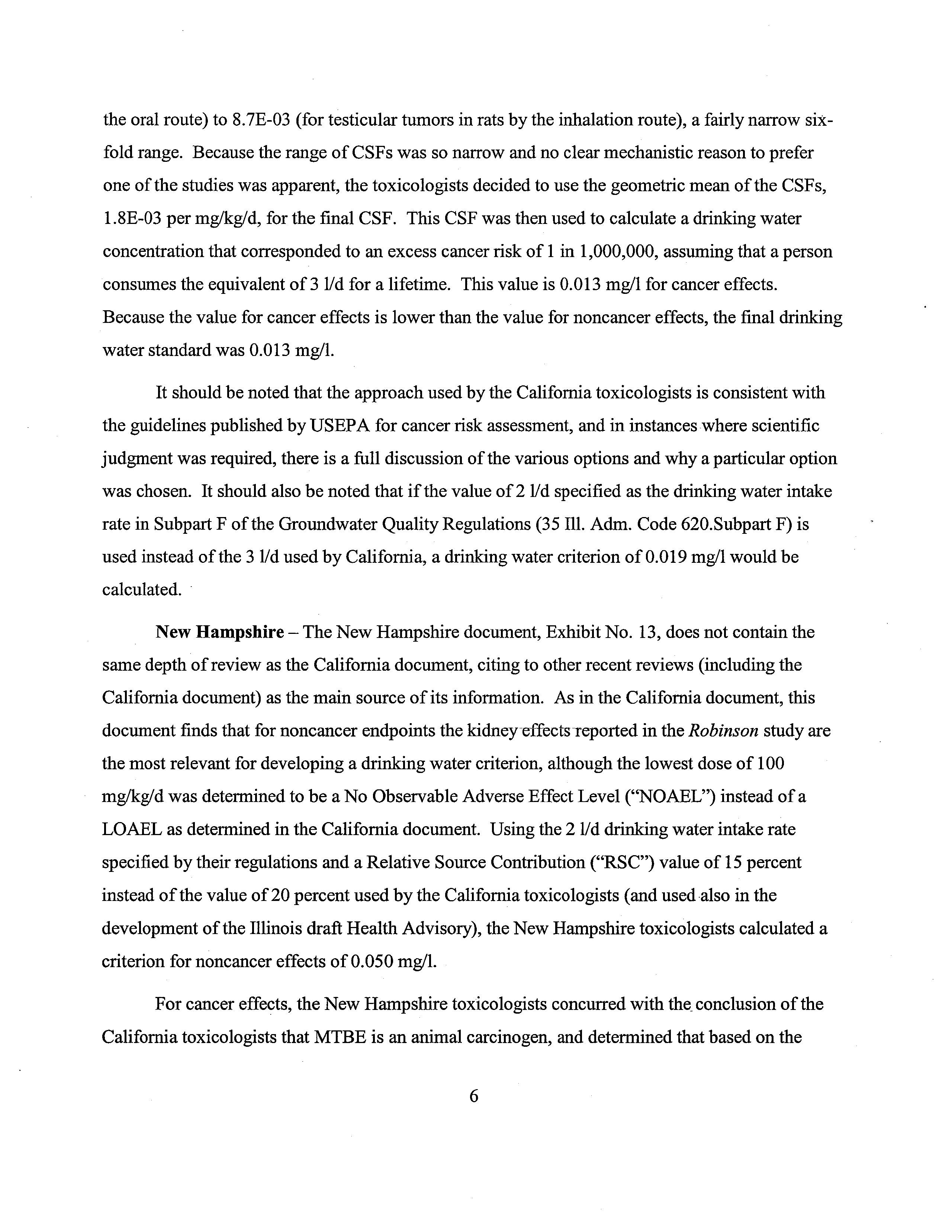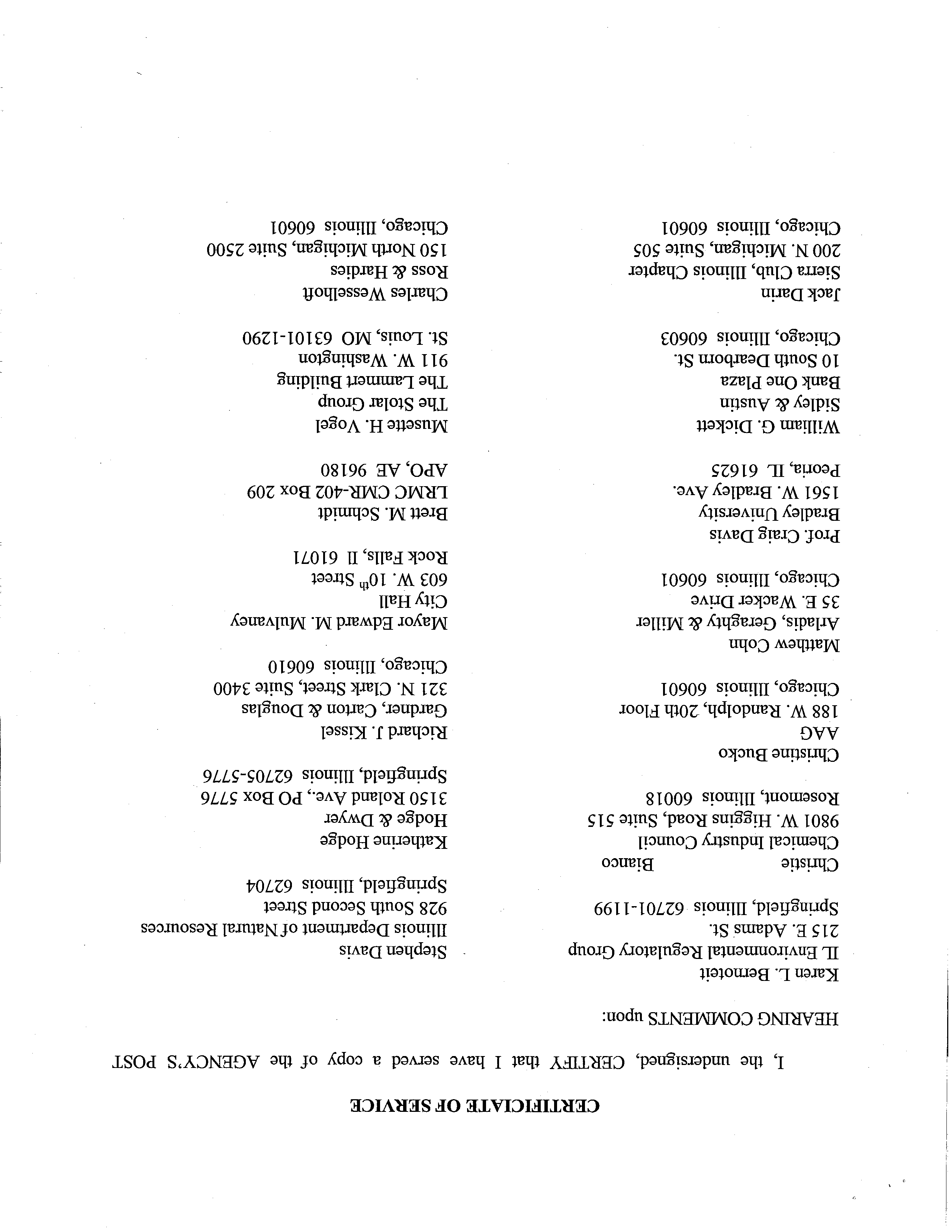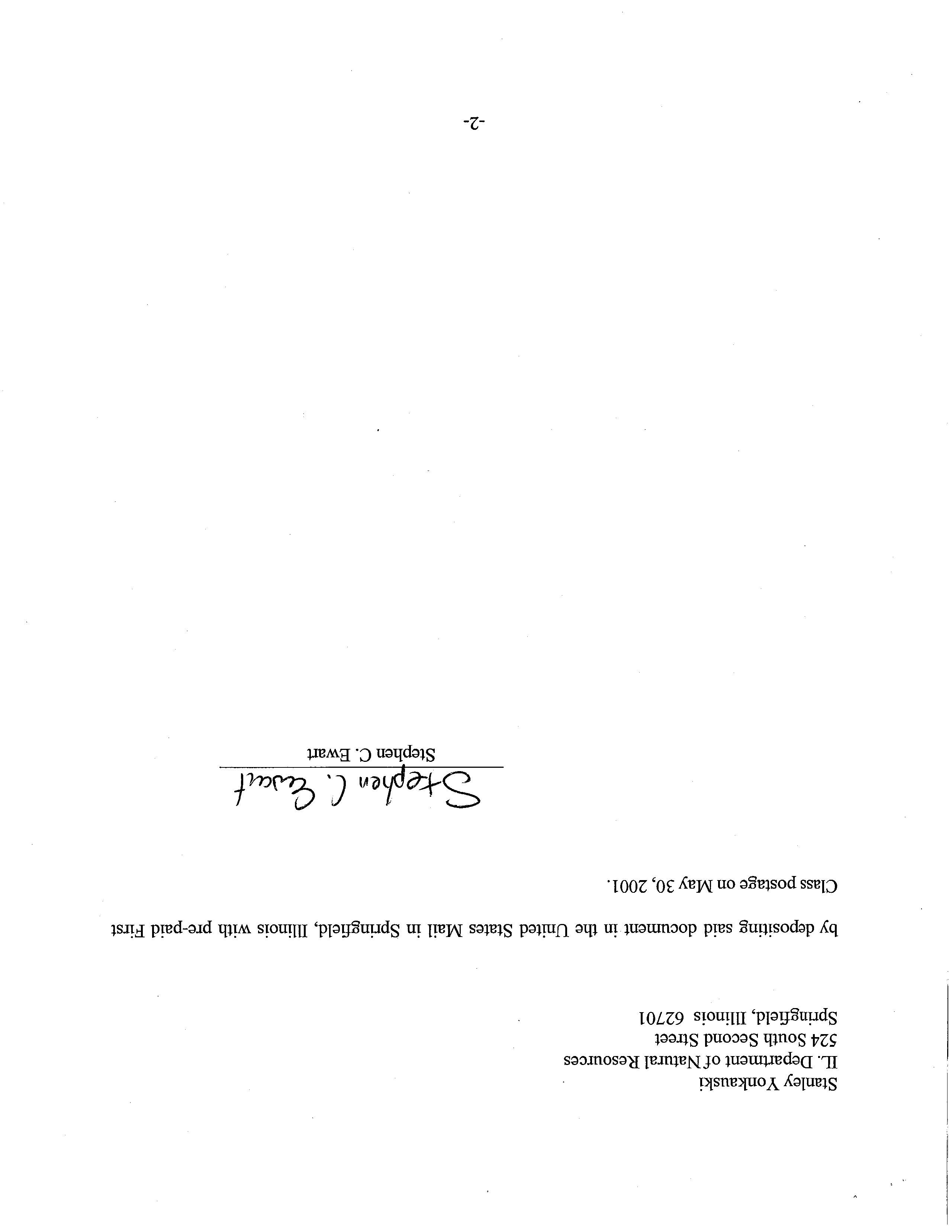BEFORE
THE
IN THE MATTER OF:
PROPOSED MTBE GROUNDWATER
QUALITY STANDARDS
AMENDMENTS:
35
ILL. ADM. CODE
620
RECEIVED
CLERK’SOFFICE
L BOARD
MAY 3
12001
STATE OF ILLINOIS
Pollution
Control Board
)
RO1-14
)
(Rulemaking
-
Water)
NOTICE OF FILING
TO
DorothyM.
Gunn, Clerk
Clerk ofthe Board
illinois Pollution Control Board
James R. Thompson Center
100 WestRandolph Street, Suite 11-500
Chicago, illinois 60601
(VIA EXPRESS MAIL)
Joel J.
Stemstein, Esq.
Hearing Officer
Illinois Pollution Control Board
James R. Thompson Center
100 West Randolph Street, Suite 11-500
Chicago, Illinois 60601
(VIA EXPRESS MAIL)
See Service List
(VIA FIRST CLASS MAIL)
PLEASE TAKE NOTICE that I have filed today with the Clerk ofthe illinois Pollution
Control Board a copy ofthe AGENCY’SPOST-HEARING COMMENTS.
A copy ofthis
document is herewith served upon each person on the attached service list.
Respectfully submitted,
ILLINOS ENVRONMENTAL
PROTECTION AGENCY
by:
SA=e~k~
Q ~
Stephen C. Ewart
Deputy Counsel
Division ofLegal Counsel
DATE:
May30, 2001
Illinois Environmental Protection Agency
1021 North Grand Avenue East
P.O. Box
19276
Springfield, illinois
62794-9276
(217)
782-5544
)
)
PRINTED ON RECYCLED PAPER
CLFR~(.S o~r~-~
M/ly
3
12001
BEFORE THE ILLINOIS POLLUTION CONTROL BOARD
STATE Op
PoIIut,
0~
Control
Board
IN THE MATTER OF:
)
)
PROPOSED MTBE GROUNDEWATER
)
RO1-14
QUALITY STANDARDS
AMENDMENTS:
)
(Rulemaking Water)
35 ILL. ADM.
CODE 620
)
AGENCY’SPOST-HEARING COMMENTS
The Illinois Environmental Protection Agency (“Agency”)respectfully submits its
post-hearing comments in the above-referenced proceeding to the Illinois Pollution
Control Board (“Board”)pursuant to
35 Ill. Adm.
Code 102.108
and at the direction of
the Hearing Officer.
During the April
5,
2001 hearing, the Hearing Officer set the
deadline for public comment to be May 18, 2001.
On May 17,
2001, the Agency filed a
motion to extend the public comment to provide additional time for comment on Methyl
tertiary Butyl Ether (“MTBE”)issues raisedby the Board.
On May 17, 2001, the Hearing
Officer granted the motion and extended the public comment deadline until June
1, 2001.
The mailbox rule does not apply.
I. OVERVIEW
Two hearings have been held on the Agency’sproposal for the amendment of35 Ill.
Adm. Code 620.
The hearings were held on March
1, 2001, in Springfield, illinois, and on
April
5,
2001, in Chicago, Illinois.
During the course ofthese hearings, approximately 129
pages oftestimony and thirteen exhibits were admitted to the record.
During the hearings, the Agency presented evidence in support of adopting
amendments to the existing Groundwater Quality Regulations,
35 Ill. Adm.
Code 620, to
include the MTBE level of 0.020 milligram per liter (“mgIl) as an amendment to the
preventive response level,
35 ill.
Adm. Code 620.3 10(a)(3)(A)(i); and the MTBE standard of
0.070 mg/i for Class
I: Potable Resource Groundwater Standard,
35 Ill. Adm. Code
620.410(b), and for Class
II: General Resource Groundwater Standard, 35 Ill. Adm.
Code
620.420(b).
In addition, the Agency provided support
for amendments to 35 Ill.
Adm. Code
620.505 which address certain deficiencies in compliance point determination conditions and
criteria, and the Agency has proposed to incorporate the definitions of “Licensed Professional
Engineer” and Licensed Professional Geologist” into the “Definitions”Section ofthe
Groundwater Quality Regulations at 35 Ill.
Adm. Code 620.110.
During the April
5,
2001 hearing, the Board introduced into the record two MTBE
studies
from California and New Hampshire for Agency technical review and comment.
In
response to this request, the Agency has included the reviewofThomas C. Hornshaw, Ph.D.
in these post-hearing comments.
II.
ISSUES RAISED BY AGENCY’S PROPOSALS
A.
“Licensed Professional Engineer” and “Licensed Professional Geologist
As proposed amendments to the definitions ofthe Groundwater Quality regulations, 35 Ill.
Adm.
Code 620.110, the Agency developed and proposed definitions for the “Licensed Professional
Engineer” and “Licensed ProfessionalGeologist,”which were different from those definitions
currently under considerationby the Board in other regulatory proceedings, 35 Ill.
Adm. Code 732
(RO1-26) and 35 Ill. Adm.
Code 740 (R01-27 and RO1-29).
Accordingly, the Agency has reviewed
these proceedings and the definitions
for “Licensed Professional Engineer” and “Licensed
Professional Geologist,” andherebymodifies the proposed definitions for 35
Ill. Adm. Code 620.110
as follows:
“Licensed Professional
Engineer~~ or “LPE”means a person, corporation or
partnership
licensed under the
laws
of this
State
to
practice professional
engineering. f~-U~GS-745J
“Licensed Professional
Geologist” or
“LPG” means an
individual
who
is
licensed under theProfessional GeologistLicensing Act [thelaws ofthe State ot
Iili*~eis4 to engage in the practice of professional geology in Illinois
pefse~na1
Fegistefed-+mdef. (Professional Geologist Licensing Act [225 ILCS 745/151
2
B.
Agency’sTechnical Review ofMTBE Studies
In response to the Board’srequest during the April
5,
2001
hearing regarding the Proposed
MTBE Groundwater Quality Standards Amendments, 35 Ill. Adm. Code 620, (“ROl-14”), Thomas
C. Hornshaw, Ph.D., Manager ofthe Toxicity Unit ofthe Agency has reviewed the
Public Health
Goalsfor Methyl Tertiary-Butyl Ether (“MTBE’)in Drinking Water
(March 1999), preparedby the
Office ofEnvironmental Health Assessment, CaliforniaEnvironmental Protection Agency
(“Exhibit No. 12”), and the
Draft Final
Technical Support Document: Derivation ofProposed
Primary and Secondary Drinking Water Standardsfor Methyl tert-Butyl Ether in NHDrinking
Water Supplies
(February, 2000) prepared by the New Hampshire Department ofHealth & Human
Services, Office ofCommunity and Public Health (“Exhibit No. 13”).
Dr. Horushaw has also
discussed the status of groundwater and drinking water standards forMTBE in New York with
Nancy Kim, Ph.D., ofthe New York State Department ofHealth.
Dr. Hornshaw’scomments on the
standards from the three states are stated below.
General
—
The standards for all three States are based on cancer risk, as Dr. Homshaw stated at
the April
5,
2001 hearing in this proceeding (T.2. pp.
38-39).
Each state has evaluated evidence ofthe
cancer-causing potential ofMTBE, as reported in articles from the scientific literature, and determined
that MTBE has the potential to cause cancer in humans. These determinations have been made by the
State toxicologists independentlyofUSEPA scientists, using procedures specified in their state
regulations to arrive at the conclusion that MTBE may cause cancer in humans.
As Dr. Hornshaw also
stated at the April
5,
2001 hearing, the determination ofcancer-causingpotential for the purposes of
establishing groundwater standards in illinois is deferred to U.S. Environmental Protection Agency’s
(“USEPA”)cancer ranking system (T.2. pp.
39-45).
The cancer risk ranking has been incorporated into
the Groundwater Quality Regulations, 35
111. Adm.
Code 620, as part of the definition of“Carcinogen,”
which states:
“Carcinogen”means a chemical, or complex mixture of closely related chemicals,
which has been listed or classified in the Integrated Risk Information System or as
specified in a final rule adopted by USEPA in accordance with USEPA
Guidelines for Carcinogenic Risk Assessment, incorporated by reference at
Section 620.125, to be a group A, B
1, orB2 carcinogen.
35111. Adm.
Code 620.110
3
California
—
The California document, Exhibit No.
12, contains a wealth ofinformation on
MTBE, including an in-depthreview ofnoncancer and cancer endpoints. Regarding noncancer
endpoints, the toxicologists reviewed studies on acute, subacute, and subchronic effects on various
organs and organ systems, including reproductive/developmental, immune system, endocrine
system, nervous system, and genetic effects.
The document also reviewed the results ofthe few
chronic studies published, which reported effects on the kidney, liver, and nervous system.
Regarding cancer endpoints, the toxicologists reviewed the results ofsix
assays: male and female
rats oftwo strains, Sprague/Dawley and Fischer 344, by the oral and inhalation routes,
respectively, and male and female mice by inhalation.
After reviewing these studies, the toxicologists developed potential drinkingwater criteria
based on both cancer and noncancer endpoints.
The following is a description ofhow the cancer
and the noncancer endpoints were derived.
Regarding noncancer effects, the toxicologists determined that the effects on the kidney
reported in the
Robinson et al.,
1990
study (“ExhibitNo.
1,
Ex. 3 and 4”)were the most relevant
toxicological
endpoint for calculation ofa drinking water criterion.
The
Robinson
study was also
the study selected by the Agency to develop its 0.070 mg/l draft MTBE Health Advisory, which
was published in the
Environmental Register, No.
484, July, 1994
(“Exhibit No. 1, Ex. 4”).
It is
important to
note that the toxicologists reviewed a nnmber ofMTBE studies, including several
published after the Agency developed the draft Health Advisory, which provided evidence for and
against the possibility that the kidney effects seen in male rats were effects unique to male rats.
(Effects, including cancer, on the kidneys ofonly male rats by some chemicals are well-recognized
phenomena, arising from damage caused whenthe chemical triggers overproduction ofthe alpha
2~-
globulin protein by the kidney.)
As a result ofthis review, the toxicologists detenninedthat the kidneyeffects reported in
MTBE studies were likely not the result ofthis mechanism, and that the kidney effects seen in the
Robinson
study were relevant to the evaluation ofhuman health risks.
In contrast, at the time the
draft Health Advisory was developed, the Agency was unwilling to conclude that these kidney
effects were not unique to male rats, preferring to defer this determination to USEPA.
Since the
4
kidney effects were seen at all doses in the
Robinson
study, the toxicologists concluded that the
lowest dose tested, 100 milligrams per kilogram per day (“mg/kg/d”), was a Lowest Observable
Adverse Effect Level (“LOAEL”), and determined that an Uncertainty Factor (“UF”)of 10,000
was appropriate in the calculation ofthe drinking water criterion. Using a formula equivalent to
the formula specified forthe calculation ofHealth Advisories in Subpart F ofthe Groundwater
Quality Regulations
(35
Ill. Adm. Code 620.Subpart F), and a water intake equivalent to 3
liters
per day (“lid”),the toxicologists derived a criterion for noncancer effects of0.047 mg/l.
For
comparisonpurposes, the draft Health Advisory developed by the Agency also determined from
the
Robinson
study that 100 mg/kg/d was a LOAEL (for diarrhea and elevated cholesterol instead
ofkidney effects) and that a UF of 10,000 was appropriate, and used the value for water intake of2
l/d specified in Subpart F to derive the 0.070 mg/l draft MTBE Health Advisory.
Thus, the basic
differencebetween the California value for noncancer effects and the draft Health Advisory for
Illinois is the use of 3 l/d versus 2 l/d as the water intake rate.
Regarding cancer effects, because the toxicologists had determined that MTBE’s effects on
the kidneywere not unique to male rats, it followed that the kidneytumors reported in the
inhalation study with male Fischer 344 rats were relevantto human cancer risk.
The toxicologists
also determined that the excess tumor incidence found in four ofthe other five cancer assays (liver
tumors in male and female mice, testicular tumors in male rats, and leukemia/lymphoma in female
rats) were relevant to human cancer risk (only the inhalation study with female Fischer 344 rats did
not produce an excess tumor incidence).
Thus, the toxicologists concluded that since MTBE
caused tumors in both sexes oftwo species by two routes ofexposure,
and that there was
consistency in the results as demonstrated by the excess numbers oftesticular tumvrs in rats by
both routes of exposure, therefore MTBE should be considered an animal carcinogen and a
possible human carcinogen.
The toxicologists then calculated a cancer slope factor (“CSF”) for eachofthe tumor types
found to have an excess incidence in the five assays.
All CSFs were expressed in units ofrisk per
mg/kg/d, which required conversion ofthe inhaled doses to oral equivalents using physiologically-
based pharmacokinetic modeling. The CSFs ranged from
1
.55E-03
(for testicular tumors in rats by
5
the oral route) to 8.7E-03 (for testicular tumors in rats by the inhalation route), a fairlynarrow six-
fold range.
Because the range ofCSFs was so narrow and no clear mechanistic reason to prefer
one ofthe studies was apparent, the toxicologists decided to
use the geometric mean ofthe CSFs,
1 .8E-03 per mg/kg/d, for the final CSF. This CSF was then used to calculate a drinking water
concentration that corresponded to an excess cancer risk of 1 in
1,000,000, assuming that a person
consumes the equivalent of3 lId for a lifetime.
This value is 0.013
mg/l forcancer effects.
Because the value for cancer effects is lower than the value for noncancer effects, the final drinking
water standard was 0.0 13 mg/l.
It should be noted that the approach used by the California toxicologists is consistent with
the guidelines published by USEPA for cancer risk assessment, and in instances where scientific
judgment was required, there is
a full discussion ofthe various
options and why a particular option
was chosen.
It should also be noted that if the value of2 lid specified
as the drinking water intake
rate in Subpart F ofthe Groundwater Quality Regulations
(35
Ill. Adm. Code 620.Subpart F) is
used instead ofthe
3
l/d used by California, a drinkingwater criterion of 0.019 mg/l would be
calculated.
New Hampshire
—
The New Hampshire document, Exhibit No.
13, does not contain the
same depth ofreview as the California document, citing to other recent reviews (including the
California document) as the main source ofits information.
As in the California document, this
document finds that for noncancer endpoints the kidneyeffects reported in the
Robinson
study are
the most relevant for developing a drinking water criterion, although the lowest dose of 100
mg/kg/d was determined to be a No Observable Adverse Effect Level (“NOAEL”)instead ofa
LOAEL as determined in the California document.
Using the 2
lid drinking water intake rate
specified by their regulations and a Relative Source Contribution (“RSC”) valueof 15 percent
instead ofthe value of20 percent used by the Californiatoxicologists (and used also
in the
development of the Illinois
draft Health Advisory), the New Hampshire toxicologists calculated a
criterion fornoncancer effects of0.050 mg/l.
For cancer effects, the New Hampshire toxicologists concurred with the conclusion ofthe
California toxicologists that MTBE is an animal carcinogen, and determined that based on the
6
USEPA cancer guidelines MTBE falls on
a continuum between a possible and a probable human
carcinogen.
In a manner similar to California’s decision, the NewHampshire toxicologists decided
to use the geometric mean ofthe CSFs calculated from each tumor type, but they determinedthat
an adjustment was necessaryfor certain results to correct for less than lifetime exposure
and also
decided to discount the importance ofthe livertumors found in male and female mice.
Thus, the
final CSF of2.83E-03 was calculated from three assay results (instead ofthe five used by
California), ranging from 2.45E-03 (for kidney tumors in male rats by the inhalation route) to
3 .24E-03
(for testicular tumors in rats by the oral route). Using the
2 lid intake rate, this CSF
results in a drinking watercriterion of0.013 mg/l forprotection against an excess cancer risk of 1
in 1,000,000.
Because this value is lower than the value for noncancer effects, this became the
final drinking water standard.
New
York
—
As ofMay 2, 2001, the date ofDr. Homshaw’s discussionofthe drinking and
groundwater standards for New York with Dr. Nancy Kim, these standards had not been formally
issued by the Governor’sOffice, so the details of the development ofthe standards
are not publicly
available.
Therefore, the Agency is providing only a brief summary ofthe derivation ofthese
standards.
Dr. Kim stated that New York regulations specify that for any organic chemical found
in drinking water or groundwater that does not have an existing standard, the initial
standard is
0.05 mg/l.
This standard remains in effect until a replacementvalue is derived from appropriate
studies ofthe chemical’s toxicity. For MTBE, the toxicologists determined, as did the California
toxicologists, that MTBE is an animal carcinogen and a possible human carcinogen.
Dr. Kim did
not specify further details ofthe calculation ofthe
CSF orthe final standards, other than to saythat
the final value was rounded to
one significant digit, or 0.01 mg/l.
III.
AGENCY PROPOSAL and
CONCLUSION
The Agency has presented testimony and comment which it believes supports the adoption
ofamendments to the existing Groundwater Quality Regulations, 35 Ill. Adm.
Code 620, to include
the MTBE level of0.020 mg/l as the amendment to the preventive response level of 35 Ill. Adm.
Code 620.3 l0(a)(3)(A)(i); and the MTBE standard of 0.070 mg/l for Class
I: Potable Resource
7
Groundwater Standard, 35 Ill.
Adm. Code 620.410(b), and Class
II: General Resource Groundwater
Standard, 35 Ill. Adm. Code 620.420(b).
In addition, the Agency hasprovided support for amendments to 35 Ill.
Adm. Code
620.505
to address deficiencies in compliance point determination conditions and criteria and forthe
inclusion of definitions of“Licensed Professional Engineer”and Licensed Professional Geologist”
to
the definitions of35
Ill. Adm.
Code 620.110.
The Agency urges the Board to adopt forFirst Notice these Agency proposals.
Respectfully submitted,
TLLINOIS ENVIRONMENTAL
PROTECTION AGENCY
By:_______________
Steph
5n
C. Ewart
Deputy Counsel
Date: May 30, 2001
1021
North Grand Avenue East
P.O. Box
19276
Springfield,
illinois 62794-9276
(217) 782-5544
THIS DOCUMENT SUBMITTED
ON RECYCLED PAPER
8
10909
SIOULIII
‘O~l?3iLlD
00&~ opn~ ‘u~IIIo!NLI1JON o~ii
06Z1-101£9
ON ‘sino’1~5
uo~uujsu~
~
116
dnolD
I~lO1S ~MI
P~OA ~H~~snw
08196
3V’OclV
60Z
xog ~017~W~ID
31AD~I’1
~P!WLIOS
~IAT
:~1aIg
I
LO
19
J]~ ‘SIII?d
)~OO}J
IWH =1!D
X~U1?AlflN iN P~’~P~
JOXEN
01909
siouijjj
‘O~1?OU[3
0017£ o}in5
~‘~S
N’~lD N l~£
~l~1~G
~‘
UO}J1?9
‘JOlJpJlWJ
l~
55D{ ~fpJ¶3~M~~{
9LL~-~0LZ9
SIOULIII ~
9L/S
XOHOd
~AVpU~lO>d0&1£
J~=MG
~‘
~POH
~POH
~ULI~Lfl~{
170L29
Sioullil ‘pPll~ui~IdS
i~~is puo~~ wnos 8Z6
sooJnoso~j 1~JUWNJO ~u~umu~douSIOUIIII
SIAEU
u~jd~iS
10909
SIOUIIII ‘O~3!LlJ
&o& ~l!ns
‘u1?~iL~,TN
N ooz
J~1d1?q~
SIOULIII ‘qnjj
1?JI~L5
uu~q ~P~f
£0909
510111111
‘O~ThMLJJ
45 uioqi~j
q~nos
01
uilsnv
~‘s’
A~IP!S
~1~)MG9
Ut~IJLPA
&Z919
‘fl’1Th1O~d
OAVX~lp1UH ~iW
l9~1
k1s1~Arufl
A~JpRIg
51A~
(1 ~ITh[D
•JOIcl
10909
SiOlflllI
‘O~3114J
UUIOD
MOWWIN
10909
510111111
‘O~?3Ufl
JOOJ~J
1fl0~ ‘1{dJopu13~
~
881
ovy
opng
ouilsuqD
8 1009
510111111
‘luoaI~so~JI
~J ~in~
pi~o~>j 5u1~1J{ UW 1086
llounoj
A.rjsnpuj l~o!T~tIo~13
661 1-10L~9
SIOUlIlI ‘p~oij~uud~
•1S 51U~PV ~
dnolD AJop?~n~O){
P~UO1~1TL1OJlAUa
‘II
:uodn
SIN~IIAII’NIODDNT~VThH
isoa
S~ADNaDV
oq~ jo =doo
pOA.1~S
OAUU~
I
imp
1~~ijpJ~)
‘p~u~is1~pun ~fl
331A)HS dO ~1VI3HI1H33
~113A~J~
u~jdo}5
J
7l2C~’)
IAd~~
iooz ‘os
1~1Nuo ~~sod ~
1SJ1J pIl?d-ald MuM
S10111111 ‘pj~ij~upd5 ‘nl!~IN sa~~ p~ui~
~ip in
uuoinnoop
pji~s
~uutsod~p
Aq
u~1us
puoo~s
wnos
tz~
s~aInosoJ P~1iW?NJO
uiI~t112.Ji?dOG
‘ii


